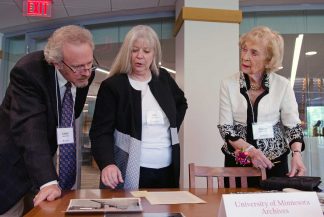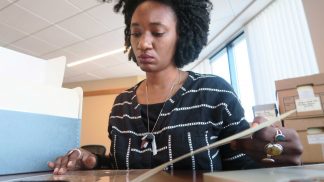By Suzy Frisch
In the peaceful, sunlit reading room of the Maxine Houghton Wallin Special Collections Research Center, Brooklyn-based artist Valerie Caesar delved into archived materials about some of her favorite authors. The room is a sharp contrast to her regular spot at the bustling New York Public Library, providing her with both physical and mental space to engage with materials in the University Libraries’ Givens Collection of African American Literature.
As an artist-in-residence, Caesar found fruitful source materials during her time at the Wallin Center, including letters, manuscripts, and articles from writers like Toni Morrison,
Gayl Jones, Alice Walker, and poet Lucille Clifton. Ultimately this research will provide fodder for Caesar’s work, including her mixed-media visual art and writing.
“The Archives provided me with a different perspective on their lives and approaches to their work,” Caesar says. “Part of the research I’m doing is showing how certain women revealed themselves to be philosophers of Blackhood. One aspect that kept coming up was how our life stories can take us on another path and train us for writing.”
A process of discovery in the Wallin Center
A process of discovery like Caesar’s occurs constantly in the Wallin Center, a new space within the Elmer L. Andersen Library. The center builds upon the Andersen Library’s legacy to be a window onto the world through its collections — available and accessible to all.
Andersen opened in 2000 with a reading room, exhibit space, and two enormous caverns that store the bulk of the University’s Archives and Special Collections. But there just wasn’t room for the James Ford Bell Library collection of rare books, manuscripts, and maps that document the history and evolution of world trade, nor for the University’s primary rare book collection. Both resided in Wilson Library for decades.
Thanks to the Wallins’ $1.5 million donation — along with support from the University — the Libraries recently moved all 97,000 items from Wilson and resettled them into two new underground vaults. It was no small undertaking, involving a year of planning, 80 staff members, and 11 weeks to move the valuable materials under the protection of a security guard, says Tim Johnson, Curator of Special Collections and Rare Books.
Now Andersen houses 15 of the University’s 17 archives and rare book collections, from the Sherlock Holmes and Performing Arts Archives to the Charles Babbage Institute Archive of Informational Technology.
Sons wanted to honor of Maxine Wallin, a former librarian

Maxine Wallin, right, browses through historical materials at the opening of the Maxine Houghton Wallin Special Collections Research Center on May 13, 2018. With her are her son Lance and Kris Kiesling, Director of the Libraries Archives and Special Collections.
The Wallin family, particularly Maxine’s sons, wanted to honor Maxine and her experience as a librarian with the gift — which is an especially fitting tribute. Maxine graduated from the University’s library studies program and cataloged rare books at the Libraries, says Kris Kiesling, the Elmer L. Andersen Director of Archives and Special Collections.
“The family was interested in improving the space that researchers use,” Kiesling says. “Maxine very much considers librarians to be her people, and I think their goal was helping us improve what we can do for people who use our collections.”
The new Wallin Center offers many improvements and additions, including the large, airy reading room on the ground floor that will help accommodate Andersen’s 3,500 annual visitors. The Center includes an exhibit space — inside the new James Ford Bell Library space — and expands the Libraries’ capacity to curate shows from its collections. Plus, a new classroom opens more opportunities for faculty and curators to instruct students and integrate rare and archival resources into the curriculum.
Center is used for research and for classes
Generally, 300 classes from the University, other colleges, and high schools meet annually at the Andersen Library. Students examine the treasure trove of archival materials, such as samples of human communication dating back to Sumerian Cuneiform and Egyptian papyrus, war posters, and original art from beloved children’s books like Uriel Birnbaum’s illustration of Alice’s Adventures in Wonderland. Thanks to the new classroom, instructors can take advantage of a document camera that allows them to zoom in and project rare materials on a large screen.
Faculty from courses covering history, geography, literature, languages, graphic design and art, social welfare, and more present material or enlist a curator to give a lecture. For example, Shakespeare classes often look at other books published during his time to assess his influences, while design students pore over early books or maps in 26 languages to study technology, society, and culture, says Bell Library Curator Marguerite Ragnow.
It’s hugely beneficial to students to engage with the materials, Johnson says, giving them a window into the richness, depth, and breadth of the Libraries’ collections.
“It’s a totally different beast than what they are used to seeing in a traditional library,” Johnson adds. “They realize that they might be able to use some of the really cool stuff that’s here for their own research projects. It can be mind-blowing for students that they have access to all of this.”
Special collections and rare books now united in one building
Ragnow is grateful for the new Wallin Center on many levels. All of the maps, manuscripts documenting trade, and books — the entire Bell Library collection — date prior to the 1800s, with some items even going back 500 to 1,000 years. Conditions for preserving these items are ideal in Andersen’s new environmentally controlled vaults.
“Now the collection is being cared for as best as it can possibly be,” she says. “That will speak to the longevity of the material and how many generations of people can use them.”
Then there is the efficiency of having all of the rare books and Bell materials united with the other special collections. No longer does Johnson need to expose rare books to Minnesota weather conditions as he transports them from Wilson to Andersen for patrons. Ragnow is thrilled to have more time for curation, outreach, and scholarship now that her small team doesn’t have to handle maintaining the physical collection at Wilson.
Curators also have more space to welcome additional researchers, too, thanks to the Wallin Center. The library welcomes researchers who visit from across the country and even around the world — including Trinity College Dublin Associate Professor Philip Coleman — an Elmer L. Andersen Scholar — who has studied Minnesota poet John Berryman. One visiting professor from New York University will return to explore the archive’s Joseph S. Mertle Collection on photomechanics — a collection she found first online.
Piquing the interest of young minds, showing everyone the possibilities, and sharing the treasures of the University of Minnesota is all part of the Libraries’ mission. Thanks to the new Wallin Center, there will be more opportunities for people to engage with this material, do research, and create their own work that continues to teach and inspire us all.





